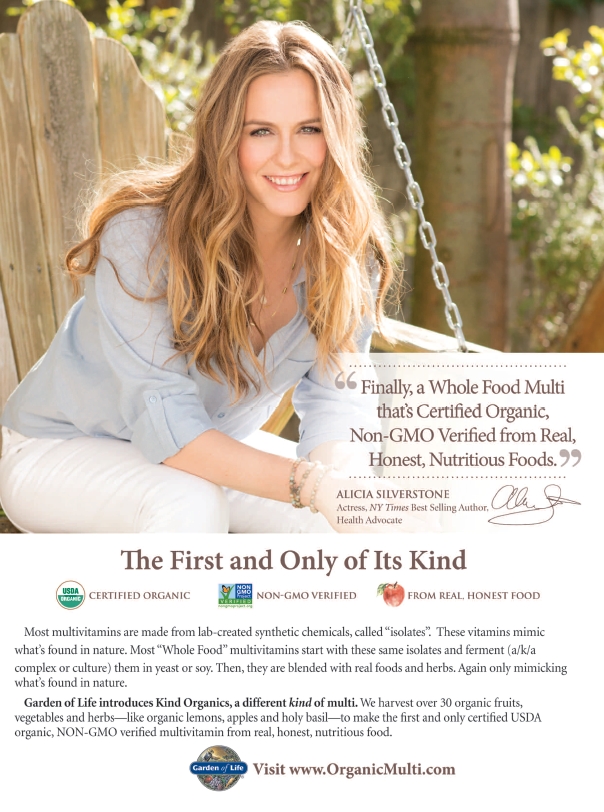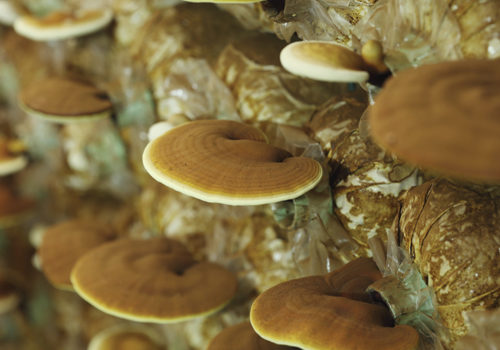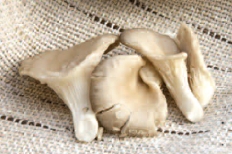Mushrooms have been a popular health aid for centuries, touted as having a variety of medicinal properties that run the gamut from immune support to fatigue reduction. Even though many may know mushrooms in the culinary sphere, education needed is about their use in supplement form in the United States.
Making a Medicinal Mushroom
To understand why medicinal mushrooms support wellness, it helps to understand a bit of their biological makeup. Many popular medicinal mushrooms derive their health benefits from polysaccharides, long molecule chains generally present in the mushroom’s cell walls (1). Polysaccharides are believed to cause hard-wired responses in certain cells, some with specific receptors for mushroom-based polysaccharides, such as Dectin-1, TLR and CR3. These three are receptors on important immune cells, which is part of the reason why mushrooms are generally believed to have immune-boosting properties. For instance, Krestin, a popular anti-cancer drug in Japan (2), is derived from turkey tail polysaccharides.
Polysaccharides are found in the majority of mushrooms, but specific species of mushroom also have more specialized components. Some examples include proteins such as flammulin in the Enokitake mushroom, which is believed to have anti-allergic properties, and triterpenes like betulinic acid in the Chaga mushroom, which is associated with anti-viral and anti-inflammatory actions, among many others (2).
Certain mushrooms also contain phenols, sterols and enzymes that have supportive properties in humans. Mushrooms in general are also good sources of essential minerals, particularly selenium, copper and potassium. These minerals help immune function and help quench free radicals (3).
One way to extract these vital nutrients is with hot water, known as decoction to some. Decoction is the practice of simmering or boiling the mushroom in water for 20–120 minutes, and this is how many medicinal mushrooms are traditionally prepared in East Asia. Some believe this is the best way to extract polysaccharides and other healthy components without damaging them. Even now, modern supplement makers turn to this method, often powdering the extract liquid then putting it into capsules before selling (1).
Other companies combine techniques like using hot water to pull out polysaccaharides, certified organic ethanol to isolate antioxidants and cold water to extract extracellular metabolites from the living mycelium (4).
Coriolus: The Defense Shield
Coriolus versicolor, also known as trametes versicolor or the turkey tail mushroom, is the subject of over 400 studies investigating its ability to support the immune system. The majority of interest in Coriolus is due to the anti-cancer properties it is believed to possess, though one cannot say that mushrooms cure, prevent or treat any diseases.
|
More on Mushrooms The mushrooms profiled in this article are some of the most popular selections for medicinal purposes, but there are many others with potential health benefits. Here are a few other mushrooms suitable for medicinal purposes.
Agaricus (Agaricus blazei): This Brazilian mushroom is believed to have the highest beta-glucan count of any mushroom, and showed anti-tumor properties in animal studies. |
In a 2012 study at The Chinese University of Hong Kong, a randomized, double-blind trial was conducted with cancer patients, some of which took Coriolus extract along with standard anti-cancer treatment, and some who took a placebo with their treatment. The study reported a 9% survival increase in those who took Coriolus versus those who took the standard treatment alone (5). The study administrators felt that this was strong evidence that Coriolus could have health benefits, particularly in sufferers of breast, gastric and colorectal cancers, though more studies would be needed.
Other studies pairing Coriolus with chemotherapy have shown increased survival rates in cervical and lung cancer patients (1). Even the U.S. Food and Drug Administration is beginning to take note of some of these results, giving the green light for a 2013 clinical trial in which advanced prostate cancer patients took the extract alongside conventional chemotherapy. Since chemotherapy suppresses the immune system, researchers from Bastyr University wanted to know if the mushroom could help maintain a healthy immune function. Another trial pending approval will involve the mushroom extract being taken alongside vaccine treatment in women with breast cancer (6).
Reishi: The 10,000-Year Mushroom
Anecdotal and scientific evidence presents the reishi (Ganoderma lucidum) as one of the most versatile medicinal mushrooms available. This versatility is due to it not only possessing numerous polysaccharides, but also over 100 different triterpenes and several amino acids, with serine and alanine being most prevalent. In addition, there are also numerous strains of reishi with slightly differing components, widening the field of possibility further (7). While the potential health benefits of the reishi mushroom are massive, the majority of scientific study revolves around three categories: immune strength, cardiovascular health and blood sugar support.
The main purported cardiovascular benefits of reishi mushrooms are stimulating circulation and lowering blood pressure. In one study, a group of hypertensive patients were given 1.3 grams of dried reishi extract four times a day over two weeks. At the conclusion of the study, the patients showed a significant reduction in plasma viscosity and blood pressure. In addition, they experienced a 59% decrease in dizziness, a 54% drop in chest tightening and a 75% decline in headaches (7). One possible reason for these effects is the suppression of angiotensin-converting enzymes (ACEs), which can indirectly cause high blood pressure by causing blood vessels to constrict (8).
While the purported immune effects of reishi are similar to Coriolus, specifically anti-tumor activity, it is also often suggested as a supplement for traditional treatments like chemotherapy, to fight off some of the negative effects of the treatments. There is some scientific evidence that suggests this as a possibility, with one study showing mice exposed to radiation experiencing higher white blood cell counts after being treated with a reishi mushroom extract (7). There is also anecdotal evidence citing alleviation of other side effects from cancer treatments, but more study is needed.
Another study offers some evidence that reishi may be able to help with blood sugar support. The phytochemicals called ganoderans A and B, both present in the mushroom, reduced blood glucose levels by a significant amount in mice when administered in doses over the course of 24 hours, with the lowest point being 59% of the control group after a seven-hour period (7).
Cordyceps: The Athlete’s Choice
Cordyceps sinensis is commonly cited for fatigue reduction, resulting in it often being suggested as a supplement for athletes and also as a sexual enhancer. Cordyceps has sold for up to $50,000 a pound in Tibet and China, and scientific evidence shows that this mushroom may have benefits to back its reputation (9).
In one study, patients took Cordyceps over the course of two months to chart its effects on cholesterol and triglycerides. At the end of the study, half the patients had more than a 10% decrease in total cholesterol as well as a 20% drop in triglycerides. There was also a 76% increase in high-density lipoprotein (HDL) cholesterol (3), known to some as the “good cholesterol” (10).
Evidence for the sexual benefits of Cordyceps is a bit more difficult to come by. One study in male patients with decreased sex drives did report a subjective increase in libido after taking Cordyceps, and there is plenty of anecdotal evidence for both genders of its effects (3). One health benefit that has more scientific attention is supporting adrenal function. Mice given a Cordyceps extract and then exposed to physical stress had adrenal glands much smaller than the control group, suggesting that the mushroom can alleviate some adrenal stress. Extrapolated to humans, this could suggest that the mushroom would lessen exhaustion and raise energy levels (11).
Maitake: A Gourmet Supplement Option
Maitake (grifola frondosa) is often treated as a culinary treat, but studies show that it has some health benefits, too. Like Coriolus, Maitake possesses several polysaccharides, specifically beta-glucans, that trigger beneficial immune system responses. As a result, some believe it can have applications with regard to supporting cancer treatment (12).
In one study, 165 advanced-stage cancer patients took either Maitake D-Fraction (a beta-glucan from the mushroom) in addition to chemotherapy or the D-Fraction by itself. In those who took only maitake, tumor regression or significant symptom improvements were observed in 11 out of 15 breast cancer patients, 12 out of 18 lung cancer patients, and seven out of 15 liver cancer patients. Taking maitake along with chemotherapy caused these rates to improve by 12–28% (4).
Polysaccharides may not be all that maitake has to offer, though. Another study was done utilizing the fruit body of the mushroom to test anti-diabetic activity in mice. The fruit body of the mushroom is the part that most of us are used to seeing, but in reality, it’s only the reproductive part of a much larger organism. For the purposes of this study, the fruit body was extracted in hot water, powdered and administered orally. Over the course of the study, blood glucose levels lowered in the mice that ate the mushroom, as opposed to the control group where it increased. Changes in the mice’s insulin and triglycerides levels were also noted (13).
Hericium: Mushroom of the Mind
Hericium erinaceus, known as Lion’s Mane for its distinct appearance, possesses the polysaccharides that most medicinal mushrooms do, and it is traditionally linked to supporting gastric health. What sets this mushroom apart from others is that it may also be able to help the brain. Two distinct classes of nerve growth factors (NGFs) have been discovered in this mushroom, and NGFs are associated with the growth of neurons in the brain. This has been a topic of some discussion in the scientific community, as no other mushrooms are currently known to have this property.
To test the potential ramifications of this discovery, a 2009 Japanese study was performed on 30 men and women from the ages of 50–80, all whom were diagnosed with mild cognitive impairment. Over the course of 16 weeks, 15 of the 30 were given a Hericium supplement four times daily. During the trial period, at weeks eight, 12 and 16, cognitive tests were performed, showing the Hericium group to have significantly increased cognitive scores compared to the control. However, in tests taken four weeks after the group had stopped taking the mushroom altogether, their scores had dramatically decreased (14). Though this and similar studies suggest a link between Hericium and cognitive benefits, further testing is required before any benefit for current neurological conditions can be determined. WF


References
1. M. Stengler, The Health Benefits of Medicinal Mushrooms (Basic Health Publications, Laguna Beach, CA, 2005).
2. M. Powell, Medicinal Mushrooms, A Clinical Guide (Mycology Press, East Sussex, UK, 2010).
3. Paul Stamets, Mycellum Running: How Mushrooms Can Help Save the World ( Ten Speed Press, New York, New York.
4. Host Defense, “The Proper Delivery Methods,” www.hostdefense.com/functional-foods/the-proper-delivery-methods, accessed June 26, 2014.
5. L.Y. Wong, et al., “Efficacy of Yun Zhi (Coriolus versicolor) on Survival in Cancer Patients: Systematic Review and Meta-Analysis,” Recent Pat. Inflamm. Allergy Drug Discov. 6 (1), 78-87 (2012).
6. Bastyr University, “FDA Approves Bastyr Turkey Tail Trial for Cancer Patients,” www.bastyr.edu/news/general-news/2012/11/fda-approves-bastyr-turkey-tail-trial-cancer-patients, distributed Nov. 30, 2012, accessed May 20, 2014.
7. R. Upton, “Reishi Mushroom, Ganoderma lucidum, Standards of Analysis, Quality Control, and Theraputics.” American Herba Pharmacopoeia and Theraputic Compendium, April 2006.
8. The Dr. Oz. Show, “Medical Uses For Mushrooms,” www.doctoroz.com/videos/medical-uses-mushrooms, accessed May 20, 2014.
9. L. Silverman, “Caterpillar Fungus: The Viagra of the Himalayas,” www.npr.org/2011/10/09/141164173/caterpillar-fungus-the-viagra-of-the-himalayas, aired Oct. 9, 2011, accessed May 20, 2014.
10. WebMD, “HDL Cholesterol, The Good Cholesterol,” www.webmd.com/cholesterol-management/hdl-cholesterol-the-good-cholesterol, accessed May 21, 2014.
11. C.D. Meletis and J.E. Barker, Herbs and Nutrients for the Mind: A Guide to Natural Brain Enhancers (Praeger Publishers, Westport, CT, 2004).
12. American Cancer Society, “Maitake Mushroom,” www.cancer.org/treatment/treatmentsandsideeffects/complementaryandalternativemedicine/dietandnutrition/maitake-mushrooms, accessed 5/19/14.
13. K.Kubo, H.Aoki and H.Nanba, “Anti-Diabetic Activity Present in the Fruit Body of Grifola frondosa (Maitake),” Biol. Pharm. Bull. 17 (8), 1106–1110 (1994).
14. K. Mori et al., “Improving Effects of the Mushroom Yamabushitake (Hericium erinaceus) on Mild Cognitive Impairment: A Double-Blind Placebo-Controlled Clinical Trial,” Phytother. Res. 23 (3), 367–372 (2009).
Published in WholeFoods Magazine, August 2014










